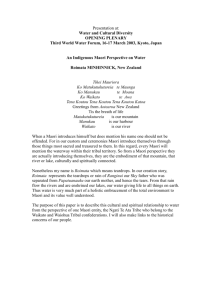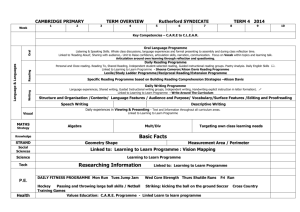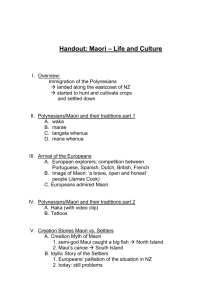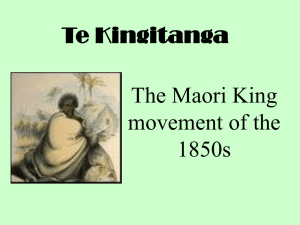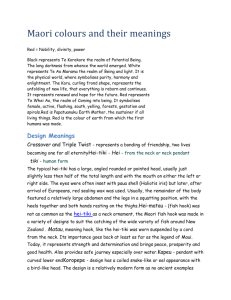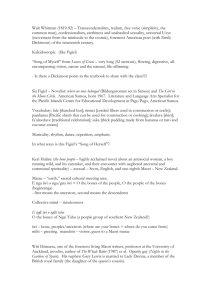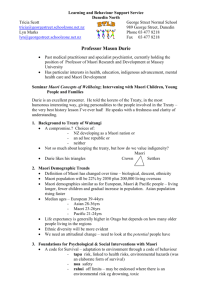Cross-Cultural Usability of Computing Metaphors
advertisement
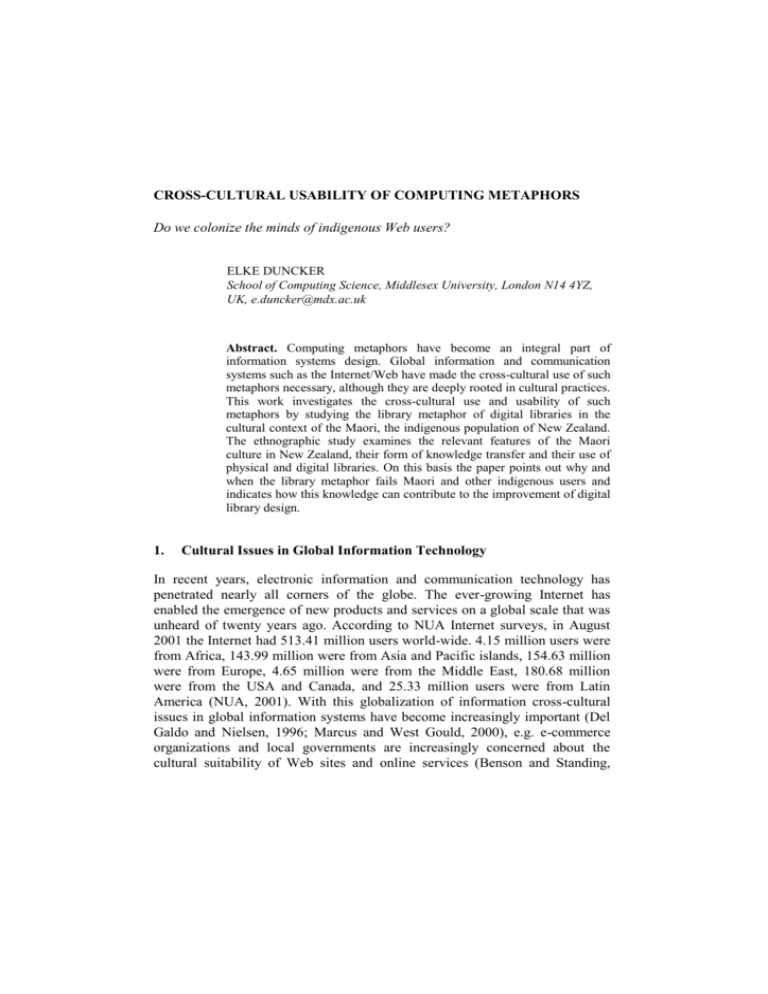
CROSS-CULTURAL USABILITY OF COMPUTING METAPHORS Do we colonize the minds of indigenous Web users? ELKE DUNCKER School of Computing Science, Middlesex University, London N14 4YZ, UK, e.duncker@mdx.ac.uk Abstract. Computing metaphors have become an integral part of information systems design. Global information and communication systems such as the Internet/Web have made the cross-cultural use of such metaphors necessary, although they are deeply rooted in cultural practices. This work investigates the cross-cultural use and usability of such metaphors by studying the library metaphor of digital libraries in the cultural context of the Maori, the indigenous population of New Zealand. The ethnographic study examines the relevant features of the Maori culture in New Zealand, their form of knowledge transfer and their use of physical and digital libraries. On this basis the paper points out why and when the library metaphor fails Maori and other indigenous users and indicates how this knowledge can contribute to the improvement of digital library design. 1. Cultural Issues in Global Information Technology In recent years, electronic information and communication technology has penetrated nearly all corners of the globe. The ever-growing Internet has enabled the emergence of new products and services on a global scale that was unheard of twenty years ago. According to NUA Internet surveys, in August 2001 the Internet had 513.41 million users world-wide. 4.15 million users were from Africa, 143.99 million were from Asia and Pacific islands, 154.63 million were from Europe, 4.65 million were from the Middle East, 180.68 million were from the USA and Canada, and 25.33 million users were from Latin America (NUA, 2001). With this globalization of information cross-cultural issues in global information systems have become increasingly important (Del Galdo and Nielsen, 1996; Marcus and West Gould, 2000), e.g. e-commerce organizations and local governments are increasingly concerned about the cultural suitability of Web sites and online services (Benson and Standing, 2 E. DUNCKER 2000). Internationalization, globalization and localization1 of information systems have become relevant topics in IT and computer science conferences2. Most prominently, language- and translation-related issues, such as differences in morphology, syntax, and character sets, have been the focus of attention for some time. Computer linguistics and machine translation have moved to new heights with the arrival of the Web (Conolli, 1996). Furthermore, variations in format conventions regarding time, date, name, address and currency, as well as varying legal requirements, have been recognized as requiring localization to suit local customs (Hall and Hudson, 1997). However, while these aspects of computer mediated global information and communication are fairly well investigated, others are not yet fully understood. Research into deeper cultural issues such as power relationships, group work, or attitudes towards technology has only just begun (Preece, 2000; Sudweeks and Ess, 2000). Among these less well understood issues are the cross-cultural understanding and use of computing metaphors. 2. Computing Metaphors Metaphors convey meaning in an unknown domain using terms of a familiar domain. Computing metaphors use everyday objects to convey the functionality of virtual objects to the user. There are intended to enable an intuitive understanding of the functionality that a user interface offers. Nowadays, computing metaphors are an integral part of user interface design, particularly of graphical user interface design. Neale and Carroll (1997) argue that computing metaphors are inevitable as overarching design strategies. However, metaphors and metaphorical thinking are deeply rooted in culture (Mac Cormac, 1985). Therefore, computer metaphors draw heavily on culturally specific knowledge. This goes for simple visual computing metaphors expressed in icons, as well as for composite metaphors on which whole applications or computing environments are based. None of these metaphors translate easily into other cultures. 1 Internationalisation is aimed at the reduction of culturally dependant items in a design and at the avoidance of culturally offending designs. Globalisation is the term preferred over internationalisation, because cultural boundaries do not necessarily coincide with national boundaries. National states often comprise multiple cultures and ethnicities, e.g. Switzerland with a French speaking population, an Italian speaking population, and a German speaking population and a single ethnic group can reach across several national states. The degree to which a technology is suited to other cultures is a hallmark of globalised technology that goes beyond the avoidance of offending designs. It requires the localisation of information systems into a particular local market or “locale” as Hall and Hudson (1997) call it. This includes the use of local (native) languages, and the design for local customs, beliefs, conventions and practices. 2 E.g. the International Workshop on Internationalisation of Products and Systems (IWIPS). CROSS-CULTURAL USE OF COMPUTING METAPHORS 3 A well-known example for a non-translating visual metaphor is the North American country mailbox with a flag set for incoming e-mail. Cultures where mail is delivered to the door or where mail is picked up from the post office may need different icons to depict incoming email. The desktop metaphor is an example for a partially translating metaphor. While the desktop metaphor itself may translate into a number of cultures, its components, e.g. trashcan, files, folders and their icons do not translate that easily. Marcus (1996) found differences in European-continental and American folders that may have consequences for the related icon. The Windows icon for folders looks like an American folder, which is a stiff paper folder with a tab for labeling. This type of folder is horizontally stored in drawers and filing cabinets. Europeancontinental and Japanese documents are stored in cardboard-box-like containers (in the UK they are called lever arch files)3. People punch two holes in the paper sheets and put them onto rings attached to the lever arch file. The lever arch files are stored on shelves in an upright position and pulled off the shelf by using a small finger hole in its vertical backside. The vertical side is also used for labeling the lever arch file. More or less elaborated labeling systems are used to ease the process of finding and pulling a document. While American folders have small tabs for labeling and are hidden away in drawers or filing cabinets, European lever arch files have much larger labels which are visible at all times. This changes searching for a document from a recall into a recognition process. Both examples, the mailbox icon and the desktop/folder icon, are not globally applicable, because the real world objects to which these metaphors refer and their use are different across cultures. In the case of the mailbox it is the shape, and the way people receive letters that is different across cultures. In the case of the desktop metaphor it is the shape of the object and the filing and search process that is different. Therefore the localization of computer metaphors cannot be achieved simply by redrawing idiomatic, non-translating icons. Cultural differences in the comprehension of metaphors go beyond the shape and color of icons. Deeper and more serious conflicts are rooted in culturally different cognitive, emotional, behavioral, and social processes and structures. Among other things they influence the user’s mental model4 of the real world object to which the metaphor refers. A computing metaphor that works well matches the appearance and functionality of the virtual object with the user’s mental model of the real world object. This mental model has been acquired from experience 3 Interestingly, both filing systems are known in the UK, hence the English term for this type of file. 4 The concept of mental models originates from cognitive psychology and plays a major role in the field of Human-Computer Interaction. They are understood as internal, cognitive projections of objects on which humans i.e. computer users base their understanding of the world. 4 E. DUNCKER with the real world object prior to using the user interface. If we accept that meaning within a given culture is established by ways of societal and cultural use of objects (Hannerz, 1992), we have to look at the use of real world objects and the cultural context in which they are used in order to understand cultural differences in the usability of computing metaphors. On this basis cultural issues of computer metaphors have to be addressed by studying 3. the use of the real world objects to which a metaphor refers the cultural context of their use the use and usability of the computing metaphor. Methods of Research Investigating the use of real world objects and their cultural context has been a traditional subject of anthropology and cultural studies. Ethnography is one of the traditional research methods in these disciplines. Originally aimed at recording the customs of exotic cultures, it has been re-interpreted, reformulated and modernized by several fields. Nowadays, ethnography includes an extended period of participant observation at the chosen site. As the researcher immerses herself into the world of her subjects she learns the significance of their language and their actions. Sociology and the field of science and technology studies have used this type of ethnography to investigate the production and consumption of scientific results and technical artifacts. Recently, computer science has recognized ethnographic methods as useful research methods. The fields of human computer interaction (HCI) and computer supported co-operative work (CSCW) have particularly shown interest in ethnography. However, there are slight but meaningful differences in the way ethnography is used. While computer scientists tend to regard ethnography as an alternative, “bottom up” method of gathering (more appropriate) data, cultural anthropologists, sociologists and particularly science and technology researchers consider ethnography as a “distinctive conceptual approach in which the relation between researcher and object of study is radically reformulated” (Cooper et al .,1995:11). Cooper et al. (1995) use a version of ethnography that has been derived from laboratory studies and sociology of scientific knowledge (SSK). They identify four main themes that characterize their version of ethnography and potentially distinguish it from ethnography as a mere data gathering method. These themes are the observer’s role, analytic skepticism, unit of analysis and ethnography as dialogue. In other words, the ethnography of anthropologists CROSS-CULTURAL USE OF COMPUTING METAPHORS 5 and sociologists includes the relationship between the researcher and the objects in the study. These themes make the analytical framework more transparent and enable a much-needed reflexivity. It is this reflexivity that is also needed for the research of cultural aspects of computer metaphors. Instead of controlling or removing the cultural bias of the researcher, the cultural background of the ethnographer has to be used to contrast and compare the findings of the field and to enter into a dialogue with those in the field who are interested in the study. 4. Digital Libraries and Maori Culture Digital libraries are organized repositories of electronic documents. They can be entirely local as well as globally organized. Repositories of global digital libraries can be distributed all over the world and can be accessed from everywhere, e.g. via the Internet. In contrast to the ‘self-organizing’ Web, the content of digital libraries is selected, organized, and maintained by an authority, usually an organization. Examples of global applications are the ACM5 Digital Library and the UN Human Development Library. The ACM Digital Library makes technical reports and articles of the ACM journals, magazines and proceedings accessible via the Web. The Human Development Library provides UN-documents related to human development and is accessible via the Web and CD-ROM. Digital library applications like these use the library metaphor to give the user an intuitive understanding of their functionality and distinguish themselves from the self-organizing Web. At first, the cross-cultural usability of the library metaphor seems a straightforward case. Libraries are a widespread phenomenon and therefore suited to metaphorical use. Libraries, i.e. organized repositories of written texts, have been known to the ancient cultures of Rome, Greece, Egypt, India, and China. More generally, cultures with written languages tend to have repositories of written texts as a form of knowledge transfer (Hannerz, 1992). However, cultures that traditionally transfer knowledge in an oral fashion often embed their knowledge in stories, artifacts and rituals. The Maori in New Zealand are such a culture. They transfer their knowledge in form of stories, songs, paintings, carvings, ritual artifacts, and rituals. They trust certain persons to learn their tribal knowledge and use these tribesmen as living repositories. Although they developed a written language (based on the English alphabet) some hundred years ago, they still rely on oral traditions and face-to-face communication for decision-making. Maori are thus an interesting case with which to examine the cross-cultural use and usability of the library metaphor in digital libraries. 5 ACM is the Association of Computing Machinery, an international computing organisation. 6 E. DUNCKER To understand the cultural overlaps and misfits in this context I have studied traditional and contemporary Maori Culture, their knowledge transfer, Maori use of Western libraries and Maori use of digital libraries. While the first three topics are part and parcel of Maori life and can be studied ethnographically, Maori use of digital libraries is not an equally widespread phenomenon and had to be studied in the artificial environment of laboratory experiments. In what follows I will briefly describe Maori culture in general and will then focus on those issues relevant for their use of physical libraries and subsequently I will describe the issues related to Maori using digital libraries. 5. Maori Culture Maori are a Polynesian culture, which originates from Southeast Asia. They settled in Aotearoa/New Zealand in several waves between 800 and 1300ct (Salmond, 1991). Most Maori tribes trace their ancestral lines back to one of the canoes with which they are said to have arrived from the homeland Hawaiki. Traditional Maori cultures vary considerably across Aotearoa, but they have a number of characteristics in common6. The main and foremost quality of all traditional Maori cultures is their focus towards the tribe and its ancestors. A number of implications follow from these characteristics: Maori are oriented towards tribal unity and collectivism, from which they draw strength and support. Tribes, sub-tribes and extended families very much emphasize consensus; things are talked through until agreement is reached. Those who leave the agreed path of consensus, or question it, are threatened with severe punishment. In former times all resources were controlled collectively. Nowadays this applies to tribal properties such as fisheries and land and to mutual support and comfort. Few culturally immersed Maori still live in this tradition. The backbone of the tribal world is genealogy. This holds true in a literal sense, as the carved meetinghouse is named after an important ancestor and its roof top beam represents the spine and side beams represent the ribs of this ancestor. In a figurative sense genealogy orders the Maori world and gives everything and everybody a place. By means of this genealogy they also live with and among their ancestors in ‘the eternal now’. They see themselves as being oriented towards the past and the ancestors and with the back to the future (Barlow, 1991). This means that their orientation in time is the complete opposite to ours as we see time progressing towards the future and we look back to the past. 6 This is comparable to European cultures, which vary, but share certain characteristics. CROSS-CULTURAL USE OF COMPUTING METAPHORS 7 Another important concept of Maori culture is ‘tapu’. The word is usually translated to ‘sacred’ and sometimes to ‘set apart’. The tribal meetinghouse is ‘sacred’, as is the knowledge of the tribe. People are set apart for being warriors or priests. There are many meanings and attendant conditions of tapu, which are difficult to understand, particularly for non-Maori. For our purpose it may suffice to understand that tapu first and foremost represents the power of the creator, but other gods endow things and people with tapu as well. Tapu can be good or bad. A whole system of sanctification and nullification keeps the various forms of tapu in balance and life workable (Barlow, 1991). Representations of people are very tapu, as are tribal genealogy, knowledge and ritual items. It does not matter whether the representations take the form of texts, pictures or carvings. They are only allowed to be used in their sacred, tribal, dignified environment with the attendant rituals in place and are treated with the utmost respect7. While traditional tribal cultures are strongly linked to the tribal land, most contemporary Maori live in the cities and form the majority of the poor population in Aotearoa/New Zealand. Most urban Maori are caught in the circle of poverty, illiteracy and unemployment with all the attendant phenomena, such as heavy drinking, domestic violence, and crime. Many of them have lost the connection with their tribes and their cultural heritage and have not found much to replace it, except perhaps for gang activities 8. Maori who have been raised with Western European values are often referred to as colonized Maori. Between culturally immersed Maori and urban, “colonized” Maori one can find 7 The Goldie oil paintings of historic Maori Chiefs are prominent examples of such representations. However, they are much more than that. For Western Europeans (Pakeha) these paintings are magnificent pieces of art and as such they are on display in the National Museum in Auckland. While I was in New Zealand these paintings were stolen. I heard it on the News. Nothing was said about potential culprits. Coming from Europe where art is stolen for money I assumed similar motives for New Zealand. When I asked my Maori colleague what he thought about the theft, he at first mumbled something like “o, were they?” On my repeated inquiries, he finally explained to me that some young Maori radicals probably stole these paintings, as it had happened repeatedly in the past. He pointed out that some Maori take offence to the paintings being displayed to everybody. In his opinion these Maori do not realise that the paintings are still in a relatively dignified and safe environment such as no Maori tribe would be able to provide. Having no place to keep them safe, the thieves would usually leave them somewhere to be found and/or would return them to the Museum via middlemen. Sure enough, a few days later, the Television reported the safe return of the paintings without mentioning the culprits. This episode shows how cultural clashes can develop around cultural artefacts that are significant to two different cultures. 8 The film “Once We Were Warriors” after a book by Alan Duff shows this aspect of contemporary Maori society. The movie achieved international fame for its unmasked brutality and witchcraft topics. 8 E. DUNCKER Maori who are mixtures of both and who try to juggle traditional Maori values with a Western lifestyle. In this conglomerate of tradition, colonization, Western rules and Western economy, a new, bi-cultural Maori elite has emerged. They are writers, lawyers, teachers, and other professionals. Maori, who go to high-school and university, are future professionals of this type. It is in this context that Maori use Western libraries and computers. In other words, Maori users of Western-style libraries and computers are mostly well-educated, bi-cultural, (future) middleclass achievers. 5.1. KNOWLEDGE TRANSFER Traditional Maori knowledge has been orally transferred. For centuries, Maori knowledge and skills have been handed down from one selected person to the next. While no individual knew everything, all knowledge was available within the tribe or sub-tribe at any given time. The keeper of the knowledge was seen as a living repository of this knowledge. He or she was supposed to ‘look after the knowledge’ which meant to memorize it in great detail, to use it for the benefit of the tribe and to pass it on to the next person selected to look after it. Genealogies were the core of traditional Maori knowledge. Even today, Maori trace their ancestors back to a particular passenger of one of the canoes in which they came. This knowledge is tapu and not for public display (Hakiwai, 1996). Over the last hundred years a lot of the traditional tribal knowledge has been lost for good and tribal knowledge transfer has changed a great deal (Ngati, 1999). With not much left to go on Maori nowadays often consult written and oral records collected by missionaries, ethnographers, interested laymen, and the Maori land courts. Two issues are related to these archives. Firstly, they were not built for the purpose for which they are used today and they are often not correct. For instance, representations of tribal relationships to the Maori land courts were made within tactical considerations aiming at keeping/gaining as much land as possible. They are not necessarily correct. Secondly, most of the content belongs and is sacred to a particular tribe, subtribe or family. According to Maori rules such records should not be publicly accessible and should be kept in sacred tribal or family vaults. Libraries and museums own quite a number of these historic collections. Some have placed access restrictions9 on them, some have not. Nonetheless, these records are the very items in public libraries that Maori are definitely interested in, mostly for the purpose of reconstructing their genealogies. However, most Maori feel strongly about the fact that these records should not be in a library in the first place. In other words, Maori records in public 9 In most of these cases the content is only accessible with the permission of the family whose records they are. CROSS-CULTURAL USE OF COMPUTING METAPHORS 9 libraries and other public places create ambiguous feelings. On the one side, Maori are interested in these records and glad they have been preserved, on the other side, the fact that they are in a public library accessible to everybody alienates them. Because of their respect for tribal knowledge and its sacredness, Maori also have great respect for Western libraries. They often assume that libraries must be very sacred places, which prevents them from entering library buildings and from using libraries. If they set foot in a library, they find a number of characteristics of Western libraries that irritate them. These aspects of Western libraries are described in the following two sections. 5.2. INCOMPATIBILITIES As much as they are friendly and welcoming with friends and extended family, Maori are extremely shy in unfamiliar situations and with unfamiliar people. They usually show little initiative to venture into unknown territory, especially if they have to leave their friends and family behind. Schools, universities and libraries require exactly the above. They focus on individual performance and individual use of resources. Maori students suffer terribly10, when they try to survive the struggle of studying and living without the comfort and support of their extended family. Maori create a special atmosphere, when they are among themselves; they make each other feel welcome. However, libraries and particularly university libraries are functional units, which provide services to readers. Maori alienation with this strictly functional approach has three aspects. The first aspect is that libraries are used silently, while Maori like communicating to each other: In the library talking is strictly forbidden. We are not used to that. When we are in the library and we find something, excitement may take over and immediately we get hushed, ssssh, quiet! Why do we have to be silent? We do not feel home in this atmosphere.11 The second aspect is that Maori find Pakeha12 librarians particularly unhelpful and abrupt. Szekely (1997) gives a large number of quotes confirming this problem. The following one is a typical example: When we get to the libraries we want someone to mihi13 to us. If there was a Maori working in the library, they can tell us exactly where we have to go. 10 It looks like an exaggeration, but Maori students suffer beyond the comprehension of Westerners, when they are separated from their families and have to face university as an individual. 11 Quotes that are not referenced originate from interviews that I conducted. 12 Maori call white New Zealanders of European origin Pakeha. 13 Mihi = to greet 10 E. DUNCKER Libraries are like Hospitals, very clinical. Staff need to be more friendly in greeting people (Szekely, 1997:16). A Maori librarian explained to me: They rather learn to use computers, search engines, and online catalogues than interacting with Pakeha librarians. Indeed, Maori are extremely helpful and supportive towards friends and family. They always go out of their way to make other people feel welcome. Even a good library service could hardly measure up to these efforts. However, even if a Maori librarian is available at the counter, as suggested above, Maori library users do not readily ask for help. In the New Zealand collection of Waikato University a Maori librarian used to be available. When observing users in this particular part of the library, I could see Maori students passing the desk at least a couple of times before they plucked up the courage to ask a question. All Maori interviewees confirmed this behavior and explained that they do not want to be a nuisance. The upshot is, if Maori use libraries, they often do not feel at ease while using them. Last but not least there are the issues of overdue books and theft. Not returned books are a problem for Maori users, because the Maori concept of borrowing does not go together with strict loan rules of Western-style libraries. Most of my Maori interviewees found it difficult to return books. Szekely (1997) found whole families having a history of not taking books back, because the books go from hand to hand instead of being returned to the library. He also found theft of particular Maori materials a problem. This type of theft is often motivated by a mixture of preventing sacred Maori knowledge from being exposed to public eyes and getting even with Pakeha institutions as the following quotes indicate: Maori user: “They stole everything, so there is no reason why we cannot steal the Maori books”(Szekely, 1997:20). Librarian: “We used to have a problem with the Maori books at the library, where people used to steal them, until ‘Tainui’14 got to the price, that so many people were stealing them, that Tainui is now at the price of $500600”(Szekely, 1997:20). Tainui is the name of one of the legendary canoes with which some Maori arrived at Aotearoa/NewZealand. The book with the title Tainui describes the history and the genealogy of the tribes descending from the passengers of the Tainui canoe. Particularly the genealogy is a problem for some Maori. They do not always steal the book, they often rip out the genealogy pages, which is not 14 Taninui is the title of a book that describes the history of the Maori tribes who descend from the passengers of the Tainui canoe. CROSS-CULTURAL USE OF COMPUTING METAPHORS 11 necessarily appreciated by other Maori users who would like to use those pages. Maori user: “I said, I’ll take you to the library and find that pukapuka 15 ‘Tainui’… When we opened that book, the whakapapa16 at the back was all taken” (Szekely, 1997:19). 5.3. DOCUMENT ORGANIZATION IN LIBRARIES While the issues above point at cultural clashes in emotional, social, and behavioral areas, issues related to the document organization in libraries are of a more cognitive nature. Document organization in Western libraries is governed by the format of the publication (e.g. journals or books) and by the classification system (e.g. Dewey-Decimal). On the one hand classification system and publication formats have to suit the content and the library user. On the other hand, library users have to understand both to a certain degree to find and access documents. 5.3.1. Western classification systems A major issue for Maori library users is the classification of Maori content. Western library classification systems make Maori content inaccessible. A recent research project on Maori information needs had found that “[English] subject headings were felt to be inappropriate” (Szekely, 1997:23). Maori knowledge, when divided into subject areas based upon Anglo-American categories, becomes scattered across the library in a seemingly random way. Texts that belong together undergo an artificial division and end up in different places. Subsequently, it becomes difficult and tiresome to find them and bring them back together again. The following quote exemplifies that: I found that some of the cataloguing as far as themes [were concerned] wasn’t very good… I actually think that some of it should be focused in one area. So this is the collection pertaining to so and so, and I know that it doesn’t fit Dewey, but he is American. He aha? (Szekely, 1997:24) The above issue has been discussed in New Zealand’s library community for some years (Smith and Sullivan, 1996, MacDonald 1993). To help this problem a Maori Subject Headings working party was launched in 1998. They have come up with formats and conventions regarding the production of Maori subject headings (Maori Subject Headings Working Party, 2000). The Maori subject headings themselves are yet to be produced, but it is hoped that these 15 16 Pukapuka = book Whakapapa = family tree, genealogy 12 E. DUNCKER subject headings will make libraries more appealing and user-friendly for Maori. 5.3.2. Publication Formats On the basis of the above it seems understandable that many Maori do not use libraries. When Maori students come to the university, they learn more or less reluctantly how to use the university library. Subsequently, and because they have to, they start using the library regularly. Nine out of thirteen Maori interviewees confirmed this attitude. Most of them had more or less dramatic stories of how they found out how the university library was organized and how they could find books and articles. Here is one of these accounts: I was in this giant law library with thousands of books and case materials. Other students seemed to go in there and miraculously found the right aisle, the right shelf and, aye, the right book. I was baffled. Thousands of books and they had the right one within minutes. […]Yea, somebody had explained to me how to use the catalogue, but I never got the hang of it. I never seemed to find anything in this catalogue. The lack of understanding of how materials in Western libraries are organized also showed during the usability experiments in the computer science department. During these experiments I observed that most Maori participants hesitated when they had to browse through journals, series, and proceedings. Triggered by this situation I asked more questions about publication formats and classification systems. It turned out that six out of eight Maori students had difficulties with five or more of the following terms: subject headings, serials, proceedings, journals, magazines, volumes, and issues. Pakeha students seemed slightly better prepared. When asked about publication formats and classification systems, three out of nine Pakeha participants had difficulties with serials, two did not know what proceedings were and one did not know what subject headings were. Considering their early non-use of libraries it does not seem surprising that Maori students lack knowledge about the organization of materials in Western libraries more often and more profoundly than their Pakeha counterparts. 5.3.3. Accessing Information The findings above are supported by earlier research regarding Maori use of public libraries. Szekely reports that ”the way library material was catalogued, classified and arranged was not understood [by Maori users]” (Szekely, 1997:23). In his 1997 report, the issue of knowing how to access information takes the second place in the list of problems, right after Maori subject headings. Below are some telling Maori quotes from Szekely’s report (Szekely, 1997:25). CROSS-CULTURAL USE OF COMPUTING METAPHORS 13 So I was a lecturer there for 5-6 years. I actually paid someone and I got information, I got boxes of it, to access it for me, photocopy it off and put it all in these boxes that are high. The biggest problem that we have is knowing how to access the information… we don’t know how to find these books. However, these problems are not insurmountable as the following quote shows: In my first year another Maori student dragged me into the library and explained to me how it worked. I would never have done that on my own. I would rather have failed my assignments than going into that building with thousands of books and strange Pakeha librarians. As a matter of fact, once he had explained to me how it all worked, it was really easy. Thus, some Maori finally come to use libraries. Whether they use them successfully or not depends on their understanding of how materials are organized in a library. This understanding apparently depends on whether or not they find somebody – typically another Maori – who ‘mihis’ them, i.e. who makes them feel welcome in the library, supports them in overcoming their threshold fear, helps them finding documents, and shows them hands-on how to use the library catalogue. 6. Maori Use of Digital Libraries It is tempting to interpret the lack of library literacy as something that Maori will (have to) catch up with. However, the matter is more complex than that. The issues raised make Western libraries not only awkward but also counterintuitive to Maori users. Libraries emphasize individualism in contrast to the collectivist Maori culture. Even though Maori knowledge transfer has changed quite a lot, Maori are still very much oriented towards verbal and nonverbal (face to face) communication, which is not allowed in Western libraries. Maori concepts like tapu, tribal privacy, and property rights are often not reflected in library policies (and do not agree with the built-in openness of the Web). Because of their desire for welcoming and warmth, Maori do not feel at home in functional Western libraries, even if the librarians are very friendly and helpful compared to Western standards. Most importantly, English subject headings and classification systems are inappropriate for Maori content and Maori are less experienced library users. Subsequently they often lack the knowledge of how materials are organized in Western libraries. These issues are reflected in the way Maori cope with the library metaphor in digital libraries. Although Maori can work with digital libraries, the library metaphor fails them in particular areas and makes the use of digital libraries 14 E. DUNCKER laborious for them. This showed in the experiments carried out at computer science department of the University of Waikato17. Pakeha and Maori participants were invited to carry out a number of search tasks and a number of browsing tasks with three digital libraries. They were asked to think aloud during the experiment and to complete usability questionnaires afterwards. However, problems, which occurred during the experiments raised some interesting issues. The first problem was to find participants of the same age group and the same level of computer experience for both cultural backgrounds. This problem was related to particular characteristics of the student population. While most Pakeha students came straight from school into university, most Maori students were mature students with an age ranging from twenty-five to pension age. Because of their age, many Maori students could not have come in contact with computers while they were young. In contrast to the Maori students, the majority of Pakeha students were younger than twenty-five and had first used computers at school age. Secondly, while all Pakeha students carried out the experiments as instructed and filled in the questionnaires with answers ranging from very good to very bad, Maori students would not ‘think aloud’ during the experiments and answered all questions in the questionnaire with the most positive answer possible. This issue arose from cultural differences of the participants. In contrast to Pakeha students Maori participants needed a communication partner to talk to. Furthermore, they never gave negative feedback. If I wanted to know anything about problems with the digital library interfaces, I had to observe their actions including their non-verbal behavior and I had to “listen to what was not being said”. As a consequence, I changed the strictly controlled experiments with no interference from my side into experiments with a collaborative dialogue between the participants and me similar to the method of contextual inquiry (Preece et al., 1994; Ruusk, 1999). Thirdly it appeared that quite a number of questionnaire questions did not make sense to the Maori participants, although I had carefully formulated them for this audience (Day and Evers, 1999; Honold, 1999). Together with the second issue this problem showed the limited usefulness of classic experiments and questionnaires for cross-cultural studies18. 17 These experiments were designed to study how Maori use digital libraries and to examine and compare the usability of digital libraries for Maori and for Pakeha. Eight Maori students and nine Pakeha students participated in the experiments. 18 Quantitative methods require a research hypothesis. This in turn requires knowledge about possible connections prior to the research project. Although it seems clear in retrospect, the link between Western classification systems of physical libraries and the usability of the library metaphor for indigenous cultures was not visible beforehand. Therefore this case study may serve as an example of how perfectly designed quantitative methods can overlook the most relevant information. However, the methodological discussion of cross-cultural studies goes beyond the scope of this paper and has to be left for another occasion. CROSS-CULTURAL USE OF COMPUTING METAPHORS 15 The findings of the experiments can be divided in culturally unrelated and culturally related usability issues. Culturally unrelated usability issues came up in all three digital libraries and included problems such as inadequate grouping of interface objects, consistency of appearance and function across various repositories of the library, endless hierarchical structures, and the lack of feedback. Usability problems like these hindered both Maori and Pakeha students, but due to their lesser computer experience Maori had to work harder to compensate for the lack of usability. This lead to prolonged task completion times for Maori. An example for such a general usability problem was the interface of a digital library that consisted of a large number of distributed repositories with documents in a variety of languages and numerous formats coming from a large variety of content providers. All users got lost in the deep hierarchies of the library. The library provided little feedback and no help to the user. Consequently, the usability of this digital library was very poor for all participants. An example of a usability problem that probably was not related to the cultural background of the participants was an interface that confusingly offered two search buttons. When the user pressed the wrong search button, the search engine returned implausible results - largely search unrelated and obviously unsorted. Four Maori students pressed the wrong button. Subsequently they neither realized the implausibility of the results nor detected the mistake of having pressed the wrong button. However, they finished their task by manually searching through the vast number of search results. Most Pakeha students used the correct button and subsequently were not confronted with the implausible results. Those who did use the wrong button (two) detected the implausibility and abandoned the results. Although there is a cultural difference in the knock-on effects the data suggest that the differences in coping with this usability problem might be related to a lack in computer experience rather than to the cultural background of the participants. Identifiably cultural usability issues were always related to Western classification systems and publication formats. An example of such a problem was a search engine that offered advanced optional features with a default configuration. This advanced search was similar to the search facilities of online library catalogues. The search engine allowed searches on particular fields such as title, full-text, abstract, reviews and index terms. All Maori students understood the terms ‘title’ and ‘full-text’, but the terms like ‘reviews’ and ‘index terms’ were not understood. Subsequently, those who tried to use the advanced options found it quite hard to use these features. If they used the advanced options at all they frequently hesitated, tried alternative action, got stuck, and either returned to the basic features or turned to me for help. Most 16 E. DUNCKER Pakeha students stuck to the basic features. The few who used the advanced features seemed to have an idea of how to go about it. The same cultural usability problem showed during the browsing tasks of the experiments. One of the browsing tasks was to find out which types of documents on which subjects were available in the three libraries. Six Maori students tried to solve this question in a first attempt by using the search engines. After a while most of them realized that this would not lead to the required information and they started searching for alternatives. One student kept going with the search engine and finally gave up. The other five tried to find alternatives. Typically they first fell silent and looked at the screen. Then I intervened and asked the reason for the silence. The following transcript was typical for these situations: Participant stops working. Silence. Researcher: “What is the matter?” Participant: “I don’t know.” Researcher: “ What are you doing?” Participant: “I am not sure. Maybe go there?” (Points at the link ‘journals and proceedings’) Participant: “Perhaps?” (Looks at researcher) Researcher: “It depends on what you want to do.” Participant is silent and looks at the screen. Researcher: are?” “Do you know what journals and proceedings Participant: “No.” Researcher explains what journals and proceedings are. Participant carries on. In the course of this conversation we usually established the lack of knowledge of Western publication formats (journals and proceedings) as a reason for their hesitation. After I gave them an explanation about journals and proceedings they carried on with their tasks, usually by browsing through journals and proceedings. The two examples above demonstrate how vital the knowledge of Western classification systems and publication formats is for the understanding of the library metaphor and the use of digital libraries. CROSS-CULTURAL USE OF COMPUTING METAPHORS 17 Conclusions Above I have described the cultural context in which Maori use libraries, computers and subsequently digital libraries. Since Maori have particular usability issues with physical Western libraries Maori find digital libraries interesting but difficult to use. Not surprisingly, the library metaphor is as counterintuitive for them as Western libraries are. The breakdown of the library metaphor is caused by a number of cultural clashes, the most important ones being that digital libraries lack culturally specific classification systems and Maori lack understanding of how materials are organized in Western libraries. The heavy dependency of digital libraries on Western classification systems and publication formats does not only exclude Maori. Other indigenous people and, more generally, anybody with little or no knowledge in Western library material organization will find digital libraries difficult to use. The more knowledge of document organization that is required, the less usable digital libraries will be for these users. What saved the digital libraries in the experiments with Maori students was the fact that they employed all their available resources to get through these experiments. One of the important resources of Maori students was their growing bi-culturality and their tenacity. It enables them to move in unknown territory despite their natural shyness. It also enables them to navigate unknown digital libraries with some success. This does not make the library metaphor culturally relevant or digital libraries efficient for Maori use. As a matter of fact, culturally inappropriate metaphors force the user, i.e. Maori, to do the translation work that is necessary to transcend cultural boundaries. With culturally relevant metaphors this boundary spanning work would be done by the information system and/or by the system developers and designers of the user interfaces. Culturally relevant digital libraries for indigenous cultures would have to offer a number of features: Firstly, they need to accommodate locally specific needs for tools such as access restriction tools for Maori content. Secondly, digital libraries need to use local classification systems i.e. culturally specific subject headings. Thirdly, digital library interfaces need to include tools that do not require knowledge of the internal organization of documents. This can be done by providing search and browsing tools that process local natural languages or phrases. An example of such a tool would be the phrase browser of the New Zealand Digital Library, which enables the user to zoom into a selection of documents that contain a particular phrase without requiring any knowledge of how these documents are organized or published. Culturally adaptable intelligent agents might be another venue of improvement in this area. Digital libraries that have been globalized and localized in the way described above would not only benefit indigenous people, they would support 18 E. DUNCKER all those users who are not familiar with Western libraries. Potential user groups of this type cannot only be found in countries with indigenous population, they would also include ethnic minorities and other less privileged groups of Western-European and North American societies. However, ethnographic studies on cultural aspects do not go down well with some computer scientists. At the best of times such studies are seen as interesting but controversial, more often they are ignored. Computers are a European/American invention. The subsequent cultural centrism of mainstream computing and its focus on a rationality that is akin to Western-European and North American cultures hinders interface and systems developers to recognize cultural differences and to develop for a multi-cultural audience. Despite ample evidence to the contrary many computer scientists and engineers still hold on to the assumption that computer technology is value free and therefore free of culture. This assumption reduces the complexity of the design task, which admittedly is highly complex given the truly enormous technical problems of digital libraries. In other words, “black boxing” the cultural aspects of technology makes the design task more workable. It also allows the designer to feel comfortable with his own cultural mindset without the necessity to ever question it. Nonetheless, things are changing. The computer industry, being less paradigmatic and more practically oriented, has detected the problem in form of failing sales and has started to take cultural issues into account. Apple, IBM, Kodak, Nokia and other companies in the communications industry are active participants in meetings like the International Workshops for the Internationalization of Products and Systems (IWIPS). They are interested in selling their products and if this means that cultural issues have to be taken into account they will (reluctantly) do so. Alternatively, if it is true that people in Europe are starting to walk away from technologies like the Internet by making conscious decisions against its use, a heretical thought raises its head. Maybe indigenous people would be better off without the experience of Western domination through global information technology? Anyhow, they should have a choice, which – in contrast to most of their European counterparts - they currently do not have. Acknowledgements I would like to thank the Computer Science Department and the Federation of Graduate University Women, University of Waikato, New Zealand; the School of Computing Science, Middlesex University, UK; my colleague Te Taka Keegan and the Maori community at the University of Waikato. CROSS-CULTURAL USE OF COMPUTING METAPHORS 19 References Barlow, C.: 1991, Tikanga Whakaaro Key Concepts in Maori Culture. Oxford University Press Oxford. Benson, S. and Standing, C.: 2000, A Consideration of Culture in National IT and E-Commerce Plans, in Sudweeks, F. and Ess, C. (eds), Cultural Attitudes towards Technology and Communication. Proceedings of the Second International Conference, Murdoch University, Australia, 2000, pp 293-303 Conolli, J.: 1996, Problems in Designing the User Interface for Systems Supporting International Human-Human Communication, in Del Galdo, E. and Nielsen, J. International User Interfaces, Wiley and Sons, New York, pp. 20-40. Cooper, G., Hine, C., Rachel, J. and Woolgar, S.: 1995, Ethnography and Human-Computer Interaction, in Thomas, P. (ed.) The Social and Interactional Dimensions of HumanComputer Interfaces, Cambridge Series on Human-Computer Interaction, Cambridge University Press, Cambridge, pp. 11-36. Day, D.: 1999, Thinking Differently, Acting Together: A Treatise on Technology Acceptance in the Era of Internationalization, in Prabhu, G. and Del Galdo, E. (eds), Workshop Proceedings of the 1st International Workshop on Internationalization of Products and Systems IWIPS’99, Backhouse Press, Rochester, New York, pp. 25-32. Day, D. and Evers, V.: 1999, Questionnaire Development for Multicultural Samples, in Prabhu, G. and Del Galdo, E. (eds) Workshop Proceedings of the 1st International Workshop on Internationalization of Products and Systems IWIPS’99, Backhouse Press, Rochester, New York, pp. 153- 162. Del Galdo, E. and Nielsen, J. (eds): 1996, International User Interfaces. John Wiley and Sons, New York. Hall, P. and Hudson, R.: 1997, Software without Frontiers, a Multi-Platform, Multi-Cultural, Multi-Nation Approach. Wiley and Sons, Chichester. Hannerz, U.: 1992, Cultural Complexity. Studies in the Social Organization of Meaning. Columbia University Press, New York. Hakiwai, A. T.: 1996, Maori Society Today: Welcome to Our World, in Davidson, J., Hakiwai, A. T. and Jahnke, R.(eds), Maori Art And Culture, British Museum Press, London, pp. 50-68. Honold, P.: 1999, “Cross-cultural” or “Intercultural” Some Findings on International Usability Testing, in Prabhu, G., and Del Galdo, E.(eds), Workshop Proceedings of the 1st International Workshop on Internationalization of Products and Systems IWIPS’99, Backhouse Press, Rochester, New York , pp 107-112. MacCormac, E. R.: 1985, A Cognitive Theory of Metaphor, MIT Press, Cambridge, MA. MacDonald, T.: 1993, Te Ara Tika Maori and Libraries, New Zealand Library and Information Association - Te Rau o Aotearoa, Wellington, NZ. Marcus, A. and West Gould, E.: 2000, Crosscurrents, ACM Interactions, 7(4), 32-46. Marcus, A.: 1996, Icon and Symbol Design Issues for Graphical User Interfaces, in Del Galdo, E. and Nielsen, J.(eds) International User Interfaces, John Wiley and Sons, New York, pp. 257-270. Maori Subject Headings Working Party (MSHWP).: 2000, Report to LIANZA/Te Rau Herenga o Aotearoa and to Te Ropu Whakahau. Neale, D. C. and Carroll, J. M.: 1997, The Role of Metaphors in User Interface Design, in Helander, M. and Landauer, T. K. (eds), Handbook of Human-Computer Interaction. Second Edition, North Holland, Amsterdam, pp. 441-462. Ngati, W.: 1999, Ko Mauripene Taku Kuia, Ko Tuhikorero Taku Koroua. Say Hi to My Elders Recording and Writing. Paper presented at the Oral History Conference Massey NZ. NUA Internet surveys: 2001, at http://www.nua.ie/surveys/how_many_online/ . 20 E. DUNCKER Preece, J.: 2000, Online Communities Designing Usability, Supporting Sociability. John Wiley and Sons. Chichester. Preece, J., Rogers, Y., Sharp, H., Benyon, D., Holland, S. and Carey, T.: 1994, Human-Computer Interaction, Addison-Wesley, Harlow, England. Ruusk, S.: 1999, Mobile Communication Devices for International Use – Exploring Cultural Diversity Through Contextual Inquiry, in Prabhu, G., and Del Galdo, E. (eds), Workshop Proceedings of the 1st International Workshop on Internationalization of Products and Systems IWIPS’99, Backhouse Press, Rochester, New York, pp. 217-226. Salmond, A.: 1991, Two Worlds. First Meetings between Maori and Europeans 1642–1772, Viking, Auckland. Smith, A. and Sullivan, R.: 1996, Maori Electronic Information: Issues and Resources, New Zealand Libraries, 48(6), 111-118. Sudweeks, F. and Ess, C. (eds): 2000, Cultural Attitudes towards Technology and Communication Proceeding of the second international conference on Cultural Attitudes towards Technology and Communication, Perth, Australia. Szekely, C.: 1997, Te Ara Tika Guiding Voices – Maori Opinion on Libraries and Information Needs. New Zealand Library and Information Association Te Rau Herenga o Aotearoa and Te Ropu Whakahau, Maori Library and Information Workers Association, Wellington, NZ.
